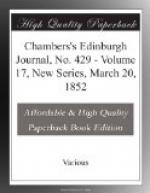India abounds in a variety of parrots and perroquets, the names of many of which I have forgotten; but the generic name is Tota. The more common are the kudjlah, teeah, and pahari. These learn to speak glibly, being generally taken out of the nest before they are fully fledged. Crutches of various kinds are selected for the poor captive, the most ingenious of which is made of a single joint of bamboo, the two ends being formed into cups—the middle part being cut, and then bent and arched over the fire; the perch being formed of a straight piece of bamboo, which joins the two cups below. A hook fastened to the top of the arch enables the owner to suspend it from the thatched ceiling of his hut; and thus the parrot swings about, listening to his master’s pious ejaculations. At dusk, many of these men may be seen parading through the bazaar, with their pets in their hands, the latter loudly vociferating that Brahma is the greatest of gods, or that Krishna and Radha were a loving couple; and so on. I have often been amused at this mode of displaying religious zeal and pious adoration.
Should you penetrate into the more crowded parts of the bazaar, you might happen to see the taste of the bird-fancier displayed after a different, but, I am happy to say, exceptional fashion. A shop may sometimes be found having a square space enclosed with a railing, with a divan in the middle, for the accommodation of the master and his visitors. On this railing a number of birds are perched, many of them little tame bulbuls; these are detained by a ligature, passing over the shoulders of the bird, and tied under the breast, leaving his wings and legs free. The bulbul, though not the bird known by that name in Persia, is a pretty songster; but he is as desperate a fighter as a gamecock. Those, therefore, who delight in cruel sports, bring their little pets to these shops, where no doubt birds of the best mettle are to be found; and on the result of a battle, money and sweetmeats are lost and won, while many a poor little bird falls a sacrifice to its master’s depraved taste. The tiny amadavad, with his glowing carmine neck, and distinct little pearly spots, may also occasionally be seen doing battle; he fights desperately, though he also warbles the sweetest of songs.




